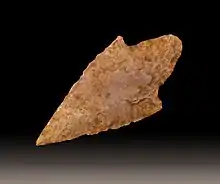Arrowhead
An arrowhead is a tip, usually sharpened, added to an arrow to make it more deadly or to fulfill some special purpose. The earliest arrowheads were made of stone and of organic materials; as human civilization progressed other materials were used. Arrowheads are important archaeological artifacts; they are a subclass of projectile points. Modern enthusiasts still "produce over one million brand-new spear and arrow points per year".[1] One who manufactures metal arrowheads is an arrowsmith.[2]
History
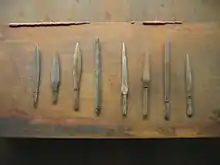
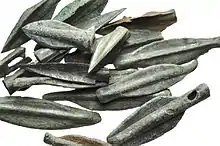
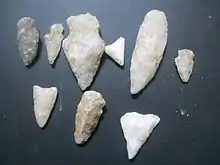
In the Stone Age, people used sharpened bone, flintknapped stones, flakes, and chips of rock as weapons and tools. Such items remained in use throughout human civilization, with new materials used as time passed. As archaeological artifacts such objects are classed as projectile points, without specifying whether they were projected by a bow or by some other means such as throwing since the specific means of projection (the bow, the arrow shaft, the spear shaft, etc.) is found too seldom in direct association with any given point and the word "arrow" would imply a certainty about these points which simply does not exist.[3]
Such artifacts can be found all over the world in various locations. Those that have survived are usually made of stone, primarily consisting of flint, obsidian or chert. In many excavations, bone, wooden, and metal arrowheads have also been found.
Stone projectile points dating back 64,000 years were excavated from layers of ancient sediment in Sibudu Cave, South Africa. Examinations found traces of blood and bone residues, and glue made from a plant-based resin that was used to fasten them on to a wooden shaft. This indicated "cognitively demanding behavior" required to manufacture glue.[4]
These hafted points might have been launched from bows. While "most attributes such as micro-residue distribution patterns and micro-wear will develop similarly on points used to tip spears, darts or arrows" and "explicit tests for distinctions between thrown spears and projected arrows have not yet been conducted" the researchers find "contextual support" for the use of these points on arrows: a broad range of animals was hunted, with an emphasis on taxa that prefer closed forested niches, including fast moving, terrestrial and arboreal animals. This is an argument for the use of traps, perhaps including snares. If snares were used, the use of cords and knots which would also have been adequate for the production of bows is implied. The employment of snares also demonstrates a practical understanding of the latent energy stored in bent branches, the main principle of bow construction. Cords and knots are implied by use-wear facets on perforated shell beads around 72,000 years old from Blombos. Archeologists in Louisiana have discovered that early Native Americans used Alligator gar scales as arrow heads.
"Hunting with a bow and arrow requires intricate multi-staged planning, material collection and tool preparation and implies a range of innovative social and communication skills."[5]
Design
Arrowheads are attached to arrow shafts to be shot from a bow; similar types of projectile points may be attached to a spear and "thrown" by means of an Atlatl (spear thrower).
The arrowhead or projectile point is the primary functional part of the arrow, and plays the largest role in determining its purpose. Some arrows may simply use a sharpened tip of the solid shaft, but it is far more common for separate arrowheads to be made, usually from metal, horn, rock, or some other hard material.
Arrowheads may be attached to the shaft with a cap, a socket tang, or inserted into a split in the shaft and held by a process called hafting.[6] Points attached with caps are simply slid snugly over the end of the shaft, or may be held on with hot glue. In medieval Europe, arrowheads were adhered with hide glue. Split-shaft construction involves splitting the arrow shaft lengthwise, inserting the arrowhead, and securing it using ferrule, sinew, rope, or wire.[7]
Modern arrowheads used for hunting come in a variety of classes and styles. Many traditionalist archers choose heads made of modern high carbon steel that closely resemble traditional stone heads (see Variants). Other classes of broadheads referred to as "mechanical" and "hybrid" are gaining popularity. Often, these heads rely on force created by passing through an animal to expand or open.
Variants
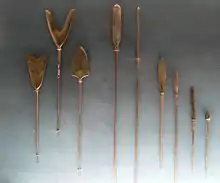
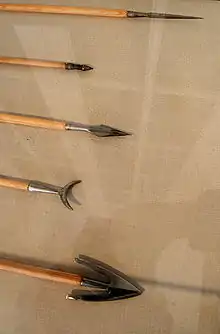
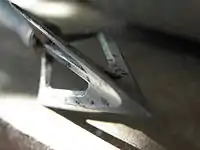
Arrowheads are usually separated by function:
- Bodkin points are short, rigid points with a small cross-section. They were made of unhardened iron and may have been used for better or longer flight, or for cheaper production. It has been suggested that the bodkin came into its own as a means of penetrating armour, however limited research[8] has so far found no hardened bodkin points, so it appears likely that it was first designed either to extend range or as a cheaper and simpler alternative to the broadhead. In a modern test, a direct hit from a hard steel bodkin point penetrated a set of fifteenth-century chain armour made in Damascus.[9] However, archery was minimally effective against plate armour, which became available to knights of fairly modest means by the late 14th century.[10]
- Blunts are unsharpened arrowheads occasionally used for types of target shooting, for shooting at stumps or other targets of opportunity, or hunting small game when the goal is to stun the target without penetration. Blunts are commonly made of metal or hard rubber. They may stun, and occasionally, the arrow shaft may penetrate the head and the target; safety is still important with blunt arrows.
- Judo points have spring wires extending sideways from the tip. These catch on grass and debris to prevent the arrow from being lost in the vegetation. Used for practice and for small game.
- Broadheads were used for war and are still used for hunting. Medieval broadheads could be made from steel,[8] sometimes with hardened edges. They usually have two to four sharp blades that cause massive bleeding in the victim. Their function is to deliver a wide cutting edge so as to kill as quickly as possible. They are expensive, damage most targets, and are usually not used for practice. There are two main types of broadheads used by hunters: The fixed-blade broadhead and the mechanical broadhead types. While the fixed-blade broadhead keeps its blades rigid and unmovable on the broadhead at all times, the mechanical broadhead deploys its blades upon contact with the target, its blades swinging out to wound the target. "There are three requirements to making a broadhead. 1. It must be wide enough to cut through tissue to produce a quick, clean kill. 2. It must be narrow enough to penetrate well. 3. It must be of a shape that can be sharpened well."[11]
The mechanical head flies better because it is more streamlined, but has less penetration as it uses some of the kinetic energy in the arrow to deploy its blades.[12]
- Three-bladed, trilobate, or Scythian arrowheads appears in regions under influence of the Scythians and ancient Persians. It was the type normally used by the Achaemenid army.[13]
- Target points are bullet-shaped with a sharp point, designed to penetrate target butts easily without causing excessive damage to them.
- Field points are similar to target points and have a distinct shoulder, so that missed outdoor shots do not become as stuck in obstacles such as tree stumps. They are also used for shooting practice by hunters, by offering similar flight characteristics and weights as broadheads, without getting lodged in target materials and causing excessive damage upon removal.
- Safety arrows are designed to be used in various forms of reenactment combat, to reduce the risk when shot at people. These arrows may have heads that are very wide or padded. In combination with bows of restricted draw weight and draw length, these heads may reduce to acceptable levels the risks of shooting arrows at suitably armoured people. The parameters will vary depending on the specific rules being used and on the levels of risk felt acceptable to the participants. For instance, SCA combat rules require a padded head at least 1 1⁄4 inches (3 cm) in diameter, with bows not exceeding 28 inches (70 cm) and 50 pounds (23 kg) of draw for use against well-armoured individuals. The Australia/New Zealand based SCA Kingdom of Lochac use 30-pound (14 kg) bows and much smaller safety arrow heads similar to modern rubber bird blunts for their combat archery as these more accurately simulate real arrows.[6]
References
- Kelley, Kevin (2010). What Technology Wants. New York: Viking. p. 55. ISBN 978-0-670-02215-1.
- Paterson Encyclopaedia of Archery p. 20
- "Glossary M - P". Uwlax.edu. Archived from the original on 11 March 2010. Retrieved 2013-01-28.
- "BBC News - Oldest evidence of arrows found". BBC. 2010-08-26. Archived from the original on 26 August 2010. Retrieved 2010-08-26.
- Marlize Lombard and Laurel Phillipson. (2010). Antiquity Vol 84:325, 2010 pp 635–648 Indications of bow and stone-tipped arrow use 64 000 years ago in KwaZulu-Natal, South Africa.
- http://www.sca.org/officers/marshal/docs/marshal_handbook.pdf
- Parker, Glenn (1992). "Steel Points". The Traditional Bowyer's Bible - Volume Two. Guilford: The Lyons Press. ISBN 1-58574-086-1.
- "Armour-piercing arrowheads". Royal Armouries. Archived from the original on 2016-03-24. Retrieved 2010-02-17.
- Pope, Saxton. Hunting with the Bow and Arrow.
To test a steel bodkin pointed arrow such as was used at the battle of Cressy, I borrowed a shirt of chain armor from the Museum, a beautiful specimen made in Damascus in the 15th Century. It weighed twenty-five pounds and was in perfect condition. One of the attendants in the Museum offered to put it on and allow me to shoot at him. Fortunately, I declined his proffered services and put it on a wooden box, padded with burlap to represent clothing. Indoors at a distance of seven yards [6 m], I discharged an arrow at it with such force that sparks flew from the links of steel as from a forge. The bodkin point and shaft went through the thickest portion of the back, penetrated an inch of wood and bulged out the opposite side of the armor shirt. The attendant turned a pale green. An arrow of this type can be shot about two hundred yards [180 m], and would be deadly up to the full limit of its flight.
- Strickland M, Hardy R. The Great Warbow. Sutton Publishing 2005. Page 272
- Quidort, Darryl. "Handmade Massey-Style Broadheads." Traditional Bowhunter. ISSN:1076-6537. February/March 2014. Page 50.
- "Mechanical vs. Fixed Broadheads". Huntingblades.com. Archived from the original on 2009-09-25. Retrieved 2010-02-17.
- Delrue, Parsival. 2007. "Trilobate Arrowheads at Ed-Dur (U.A.E, Emirate of Umm Al-Qaiwain)". Arabian Archaeology and Epigraphy. 18, no. 2: 239-250.
External links
| Look up arrowhead in Wiktionary, the free dictionary. |
![]() Media related to Arrowheads at Wikimedia Commons
Media related to Arrowheads at Wikimedia Commons
